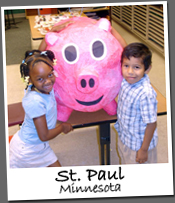A remarkably diverse group of more than 40,000 children attend public schools in St. Paul, Minnesota. St. Paul students come from all over the world and speak more than 70 languages and dialects. More than 40 percent are from homes where a language other than English is spoken and more than two-thirds are eligible for free and reduced price lunch. The challenges confronting low-income students are felt particularly keenly in the school district’s afterschool programs. More than nine in ten afterschool students receive free and reduced price lunch. Needless to say, these children come to afterschool with a wide array of needs. With the help of grant funds from the 21st Century Community Learning Centers (21st CCLC) initiative, afterschool program staff are working hard to meet these children’s needs. The 21st CCLC programs in St. Paul, which began with a handful of sites in 1998, have consistently targeted the children and youth who most stand to benefit from the combination of academic and enrichment activities they offer. Since its inception, the program has expanded to nine schools and nearly 2,000 participants. The program earns enthusiastic praise from teachers, principals and parents alike. In surveys, teachers note improvements in participants’ behavior, school preparedness and work habits. Principals say that the programs are reaching the right students and strengthening relationships between teachers and students in new ways. Parents like that the programs provide a safe and affordable place for their kids to go after school, reinforce learning and provide help with homework. Perhaps most importantly, parents also report that their children like the programs and look forward to going. Individual schools and the district as a whole have been exceptionally supportive of the afterschool programs. Community members and teachers staff the programs, and the district provides free space in the schools. The local Alternative Learning Center provides much of the academic programming program, 4H and another local group provide tutoring and the Department of Agriculture provides snacks. Even with this broad base of support, St. Paul’s 21st CCLC coordinator stresses that demand for afterschool programming far outstrips what the district is able to offer. “The benefits of our 21st Century Programs,” says Debi Campobasso, Community Education Coordinator for St. Paul Schools, “are far reaching – from keeping kids in a safe supervised environment after school, to improving student achievement and self confidence, to developing community partnerships which lead to strong support for all students.” But a number of sites have long waiting lists, she points out. And while the city has stepped in to offer additional programming through the parks and recreation department, a significant need remains. The 21st CCLC program has shown the community what is possible during out-of-school-time hours. The challenge now is to build the program’s capacity so that all children will have access to quality afterschool. | 







